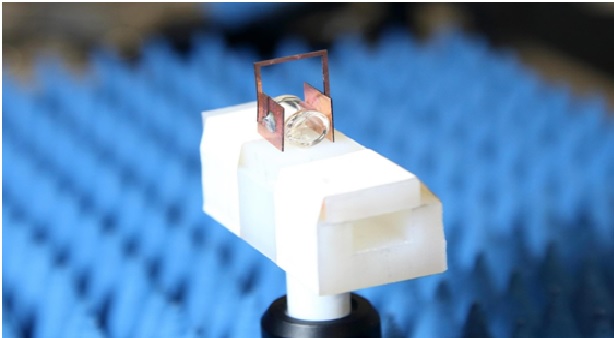Custom Copper “Headphones” Boost Atomic Radio Reception 100x
Scientists at the National Institute of Standards and Technology (NIST) have increased the sensitivity of their atomic radio receiver a hundredfold by enclosing the small glass cylinder of cesium atoms inside what looks like custom copper “headphones.”
The structure — a square overhead loop connecting two square panels — boosts the incoming radio signal, or electric field, applied to the gaseous atoms in the flask (known as a vapor cell) between the panels. This enhancement enables the radio receiver to detect much weaker signals than before. [1]

Figure 1.The Custom Copper “Headphones” Boost Atomic Radio Reception 100x
Figure 1 shows NIST researchers previously demonstrated the atom-based radio receiver. An atomic sensor has the potential to be physically smaller and perform better in noisy environments than traditional radio receivers, among other potential benefits.
The vapor cell is about 14 millimeters (0.55 in) long and 10 mm (0.39 in) in diameter, about the size of a fingernail or a computer chip but thicker. The resonator overhead loop is approximately 16 mm (0.63 inch) on a side and the ear covers are approximately 12 mm (0.47 inch) on a side. [2]
A radio signal applied to the new resonator creates currents in the overhead loop, which produces a magnetic flux, or voltage. The dimensions of the copper structure are smaller than the radio signal’s wavelength. As a result, this small physical gap between the metal plates has the effect of storing energy around the atoms and enhancing the radio signal. This boosts performance efficiency, or sensitivity.
The loop and gap sizes determine the natural, or resonant, frequency of the copper structure. In the NIST experiments, the gap was just over 10 mm, limited by the outside diameter of the available vapor cell. The researchers used a commercial mathematical simulator to determine the loop size needed to create a resonant frequency near 1.312 gigahertz, where Rydberg atoms switch between energy levels. [3]
With additional growth, atom-based receivers may offer many benefits over conventional radio technologies. For example, the atoms act as the antenna, and there is no need for traditional electronics that convert signals to different frequencies for delivery because the atoms do the job automatically. The atom receivers can be physically smaller, with micrometer-scale dimensions. In addition, atom-based systems may be less susceptible to some types of interference and noise. [4]
References:
- https://scitechdaily.com/custom-copper-headphones-boost-atomic-radio-reception-100x/
- https://techsens.in/custom-copper-headphones-boost-atomic-radio-reception-100x/
- https://scivtech.com/technology/custom-copper-headphones-boost-atomic-radio-reception-100x/
- https://newscentral.site/custom-copper-headphones-boost-atomic-radio-reception-100x/?sfw=pass1661231847
Cite this article:
Thanusri swetha J (2022), Custom Copper “Headphones” Boost Atomic Radio Reception 100x, Anatechmaz, pp. 404

